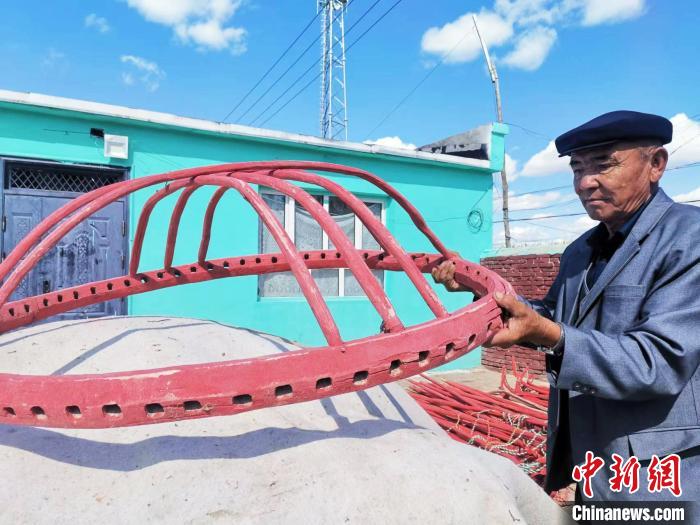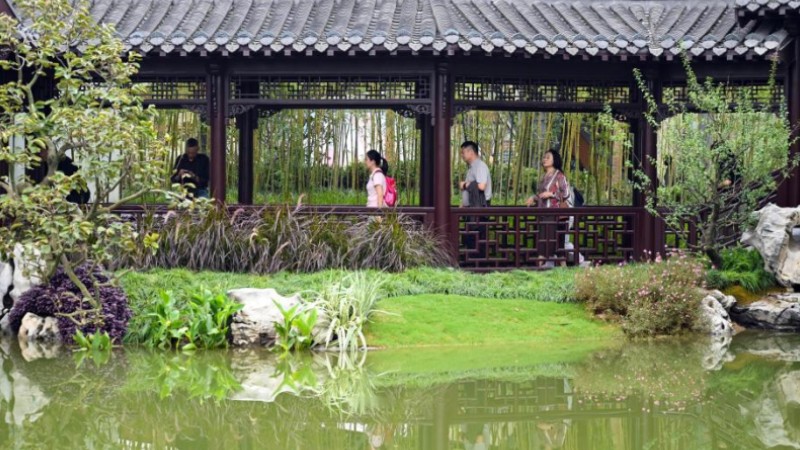Intangible cultural heritage inheritor in China's Xinjiang devoted to building 'mobile homes' for herdspeople for five decades
Dalelkhan Kabdesh, a representative inheritor of the yurt-making craft of the Kazakh ethnic group, has been building Kazakh yurts, a type of traditional portable dwelling used by nomads, for more than 50 years.
Yurts have an extremely significant place in the nomadic lifestyle of herdspeople, and are regarded as their "mobile homes".

Dalelkhan Kabdesh shows the roof hoop of a yurt. (Photo/Chinanews.com)
"Herdspeople move more than 10 times a year, living in yurts for most of the year except winter," said Dalelkhan Kabdesh. Born into a herdsman's family in Emin county, northwest China's Xinjiang Uygur Autonomous Region, in 1955, he has wanted to build a durable yurt for his family since he was young.
In 1971, Dalelkhan Kabdesh started to learn yurt-making techniques from his grandfather, uncle and father, among other people. He has so far constructed over 50 yurts by himself, and built more than 200 of the special dwelling in collaboration with others.
Yurt-making is an ancient craft of the Kazakh people. The overall structure is designed to be lightweight but sturdy for easy assembly and disassembly. The dwelling is completely made by hand.
The cylindrical structure of a Kazakh yurt comprises components including a roof hoop, frame, door, felt wall, lattice, and roof blanket. The roof hoop is connected with the frame through drilled holes, and the frame is joined to the lattice, thus forming the overall structure of a Kazakh yurt. The dwelling is basically completed after the overall structure is covered with felt blankets.
"Each step seems simple but requires meticulous work and careful selection of materials," Dalelkhan Kabdesh said, explaining that wood used for different parts of a yurt are made from different species of trees.

Dalelkhan Kabdesh (left) displays a yurt lattice with his son-in-law. (Photo/Chinanews.com)
"A quality yurt can last 30 years," he added.
Yurt-making was recognized as China's national-level intangible cultural heritage in 2008. Later, Dalelkhan Kabdesh was designated as a representative inheritor of this heritage. His outstanding craftsmanship makes his yurts sturdy and popular among local herders.
Nowadays, herdspeople in Xinjiang's pasturing areas live in houses with better amenities and are more disaster-resilient. With the advancement of industrialization, metal-pipe yurts emerged in the market, impacting the traditional yurt-making craft.
However, according to Dalelkhan Kabdesh, more people have been looking to him for instruction and guidance on making Kazakh yurts, and he has received more orders from scenic areas for them.
"Traditional yurts represent Kazakh customs and memories," noted Dalelkhan Kabdesh, explaining that many herdspeople of the Kazakh ethnic group still build yurts at their settlements for gatherings.
Moreover, Xinjiang's booming tourism sector has expanded the craft's reach.
Since 2000, Dalelkhan Kabdesh has trained 23 apprentices, 13 of whom can now build yurts independently.
"Now that we have good national policies supporting the protection and inheritance of intangible cultural heritage, and people are interested in yurts, I'll keep passing on this craft as long as I'm able to do it," said Dalelkhan Kabdesh passionately.
Photos
Copyright © 2023 People's Daily Online. All Rights Reserved.









